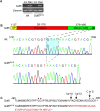Dach2-Hdac9 signaling regulates reinnervation of muscle endplates
- PMID: 26483211
- PMCID: PMC4712835
- DOI: 10.1242/dev.125674
Dach2-Hdac9 signaling regulates reinnervation of muscle endplates
Abstract
Muscle denervation resulting from injury, disease or aging results in impaired motor function. Restoring neuromuscular communication requires axonal regrowth and endplate reinnervation. Muscle activity inhibits the reinnervation of denervated muscle. The mechanism by which muscle activity regulates muscle reinnervation is poorly understood. Dach2 and Hdac9 are activity-regulated transcriptional co-repressors that are highly expressed in innervated muscle and suppressed following muscle denervation. Dach2 and Hdac9 control the expression of endplate-associated genes such as those encoding nicotinic acetylcholine receptors (nAChRs). Here we tested the idea that Dach2 and Hdac9 mediate the effects of muscle activity on muscle reinnervation. Dach2 and Hdac9 were found to act in a collaborative fashion to inhibit reinnervation of denervated mouse skeletal muscle and appear to act, at least in part, by inhibiting denervation-dependent induction of Myog and Gdf5 gene expression. Although Dach2 and Hdac9 inhibit Myog and Gdf5 mRNA expression, Myog does not regulate Gdf5 transcription. Thus, Myog and Gdf5 appear to stimulate muscle reinnervation through parallel pathways. These studies suggest that manipulating the Dach2-Hdac9 signaling system, and Gdf5 in particular, might be a good approach for enhancing motor function in instances where neuromuscular communication has been disrupted.
Keywords: Brachypodia; Dach2; Denervation; Gdf5; Hdac9; Motor nerve; Muscle; Myogenin; Nerve; Neuromuscular junction; Regeneration.
© 2015. Published by The Company of Biologists Ltd.
Conflict of interest statement
The authors declare no competing or financial interests.
Figures










Similar articles
-
Activity-dependent gene regulation in skeletal muscle is mediated by a histone deacetylase (HDAC)-Dach2-myogenin signal transduction cascade.Proc Natl Acad Sci U S A. 2006 Nov 7;103(45):16977-82. doi: 10.1073/pnas.0601565103. Epub 2006 Oct 30. Proc Natl Acad Sci U S A. 2006. PMID: 17075071 Free PMC article.
-
Histone deacetylase 9 couples neuronal activity to muscle chromatin acetylation and gene expression.Nat Neurosci. 2005 Mar;8(3):313-21. doi: 10.1038/nn1408. Epub 2005 Feb 13. Nat Neurosci. 2005. PMID: 15711539
-
The histone deacetylase HDAC4 connects neural activity to muscle transcriptional reprogramming.J Biol Chem. 2007 Nov 16;282(46):33752-33759. doi: 10.1074/jbc.M706268200. Epub 2007 Sep 16. J Biol Chem. 2007. PMID: 17873280
-
Histone deacetylase (HDAC) 9: versatile biological functions and emerging roles in human cancer.Cell Oncol (Dordr). 2021 Oct;44(5):997-1017. doi: 10.1007/s13402-021-00626-9. Epub 2021 Jul 27. Cell Oncol (Dordr). 2021. PMID: 34318404 Free PMC article. Review.
-
Role of nitric oxide and nitric oxide synthases in experimental models of denervation and reinnervation.Microsc Res Tech. 2001 Nov 1;55(3):181-6. doi: 10.1002/jemt.1169. Microsc Res Tech. 2001. PMID: 11747093 Review.
Cited by
-
Quis Custodiet Ipsos Custodes (Who Controls the Controllers)? Two Decades of Studies on HDAC9.Life (Basel). 2021 Jan 27;11(2):90. doi: 10.3390/life11020090. Life (Basel). 2021. PMID: 33513699 Free PMC article. Review.
-
Sarcoglycan Alpha Mitigates Neuromuscular Junction Decline in Aged Mice by Stabilizing LRP4.J Neurosci. 2018 Oct 10;38(41):8860-8873. doi: 10.1523/JNEUROSCI.0860-18.2018. Epub 2018 Aug 31. J Neurosci. 2018. PMID: 30171091 Free PMC article.
-
REDD1 induction regulates the skeletal muscle gene expression signature following acute aerobic exercise.Am J Physiol Endocrinol Metab. 2017 Dec 1;313(6):E737-E747. doi: 10.1152/ajpendo.00120.2017. Epub 2017 Sep 12. Am J Physiol Endocrinol Metab. 2017. PMID: 28899858 Free PMC article.
-
Neuron-specific deletion of CuZnSOD leads to an advanced sarcopenic phenotype in older mice.Aging Cell. 2020 Oct;19(10):e13225. doi: 10.1111/acel.13225. Epub 2020 Sep 4. Aging Cell. 2020. PMID: 32886862 Free PMC article.
-
Chronic jet lag-like conditions dysregulate molecular profiles of neurological disorders in nucleus accumbens and prefrontal cortex.Front Neuroinform. 2022 Dec 13;16:1031448. doi: 10.3389/fninf.2022.1031448. eCollection 2022. Front Neuroinform. 2022. PMID: 36582489 Free PMC article.
References
-
- Berghella L., De Angelis L., De Buysscher T., Mortazavi A., Biressi S., Forcales S. V., Sirabella D., Cossu G. and Wold B. J. (2008). A highly conserved molecular switch binds MSY-3 to regulate myogenin repression in postnatal muscle. Genes Dev. 22, 2125-2138. 10.1101/gad.468508 - DOI - PMC - PubMed
Publication types
MeSH terms
Substances
Associated data
- Actions
Grants and funding
LinkOut - more resources
Full Text Sources
Other Literature Sources
Molecular Biology Databases

